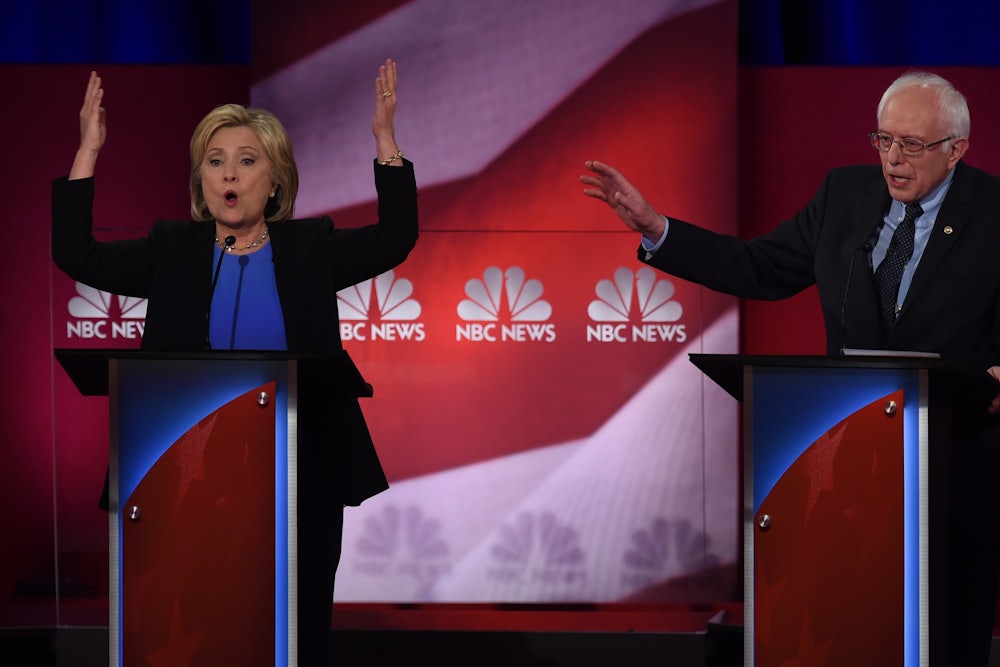It is a testament to the presence of Elizabeth Warren in the Democratic Party that Wall Street reform has emerged as a major plank in the 2016 primary, even more so than 2008, when the world was in the midst of collapsing due to financial sector fraud. Every debate has featured a long back and forth about financial reform, but Sunday night’s debate delved even deeper into Hillary Clinton and Bernie Sanders’s difference on the issue. The divide boils down to a basic question: Do the big banks simply need more regulatory restraints, or do they need to be broken up?
Sanders continued to argue that Wall Street has grown too big, too politically powerful, and too unmanageable. He evoked Theodore Roosevelt in saying that they ought to be broken up, with deposits separated from investment banking activities (it would be nice if he made the Roosevelt comparison complete by designating the mega-banks an antitrust issue). Clinton began, as she did several times in the debate, by using President Barack Obama as a shield; with the debate held in Charleston, Obama’s 90 percent approval rating among South Carolina Democrats is worth remembering here. She criticized Sanders for demeaning Dodd-Frank, “one of the most important regulatory schemes we’ve had since the 1930s.” This is a low bar, given that the Depression-era reforms generally worked until they were dismantled piece by piece starting in the 1970s.
Clinton continues to appeal to authority by saying that “most commentators” agree that her financial reform plan is “tougher, more effective, and more comprehensive.” But her plan doesn’t deal with the credit rating agencies, universally acknowledged as a major driver of the financial crisis and completely unreformed; Sanders includes rating agency reform in his plan. Moreover, just last week Sanders released a statement from 170 economists and financial experts who favor his approach on reform. Not only is this a list of candidates for key financial regulatory positions inside a hypothetical Sanders administration, it represents the side of the intra-Democratic divide that favors more stringent treatment of Wall Street. To back up her “most commentators” claim, Clinton cited two validators: Paul Krugman and Barney Frank. But Frank is a policy advisor to Clinton, who provided input on her proposal. That he supports it is therefore not much of a surprise.
Re-upping a line of attack from previous debates, Clinton hit Sanders for voting for the Commodity Futures Modernization Act (CFMA) in 2000. “You’re the only one on this stage that voted to deregulate the financial market … to make the SEC and the Commodities Futures Trading Commission no longer able to regulate swaps and derivatives, which were one of the main causes of the collapse in ’08,” she said. Sanders initially voted for a more benign version of what became the law, as Zach Carter has explained. The final CFMA, sharpened by Phil Gramm and Bill Clinton’s top officials into something far more deregulatory, ended up in an omnibus spending bill; a vote for it was a vote to keep the government funded.
But what’s interesting here is that Clinton cited swaps and derivatives as a main cause of the 2008 crisis. The traders in those derivatives were big banks, the very entities whose responsibility for the meltdown she has tried to downplay. To this day, four banks—JPMorgan Chase, Citi, Bank of America, and Goldman Sachs—account for 91 percent of total derivatives exposure. HSBC, Wells Fargo, and Morgan Stanley also have significant holdings. The most efficient way to minimize threats from derivatives is to ring-fence the risk, as Sanders’s plan does and Clinton’s doesn’t.
Near the end, Clinton made a critical point: Dodd-Frank “gives us the authority already to break up big banks that pose a risk to the financial sector.” Not only is that true, there are actually multiple ways to do it under existing law. In Section 121, a two-thirds vote of members of the Financial Stability Oversight Council, a “super-regulator” composed of leaders from the other banking oversight agencies, can direct a financial firm to break up because it threatens “financial stability.” In Section 165, regulators from the Federal Reserve and the FDIC can restrict “the growth, activities, or operations” of a big bank if they determine that their “living wills,” roadmaps for how to break up the firm if it runs into trouble, are not credible. Incidentally, the FDIC ruled that living wills for the largest eleven banks were not credible over a year ago.
The fact that Dodd-Frank provides tools to downsize the financial sector changes the debate considerably. Your precise legislative plan matters less than your political will and the will of your appointments. Sanders’s bank breakup bill is indeed insubstantial and vague. But he cited Section 121 in his Wall Street reform speech; he knows that any legislation on that point is actually duplicative and unnecessary.
Martin O’Malley correctly replied to Clinton, after she noted that Dodd-Frank contained the authority to break up banks, that “we have never used it.” A Sanders administration stocked with aggressive appointees would be likely to change that; in the debate he vowed never to hire a Treasury secretary who has previously worked at Goldman Sachs (as Hank Paulson and Robert Rubin had). Clinton said last night, “there should be no bank too big to fail,” but whether she would use existing power is questionable, since her entire posture has reflected a desire to tinker with financial regulation rather than overhaul the sector.
Reasonable people may consider Clinton’s the superior option, responding in the least disruptive way to maintain financial stability. But if you believe that our economy is too closely tied to the financial sector, that over-financialization creates too much unproductive activity, too much wealth inequality, and too much political power, you may believe in breaking that power as essential to a stronger society. That’s really the choice facing Democratic voters today.
